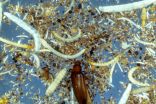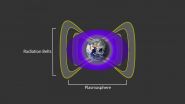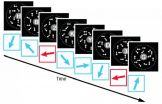(Press-News.org) MADISON, Wis. -- It was fishermen off the coast of Peru who first recognized the anomaly, hundreds of years ago. Every so often, their usually cold, nutrient-rich water would turn warm and the fish they depended on would disappear. Then there was the ceaseless rain.
They called it "El Nino," The Boy -- or Christmas Boy -- because of its timing near the holiday each time it returned, every three to seven years.
El Nino is not a contemporary phenomenon; it's long been the Earth's dominant source of year-to-year climate fluctuation. But as the climate warms and the feedbacks that drive the cycle change, researchers want to know how El Nino will respond. A team of researchers led by the University of Wisconsin's Zhengyu Liu published the latest findings in this quest Nov. 27, 2014 in Nature.
"We can't see the future; the only thing we can do is examine the past," says Liu, a professor in the Department of Atmospheric and Oceanic Sciences. "The question people are interested in now is whether it's going to be stronger or weaker, and this requires us to first check if our model can simulate its past history."
The study examines what has influenced El Nino over the last 21,000 years in order to understand its future and to prepare for the consequences. It is valuable knowledge for scientists, land managers, policymakers and many others, as people across the globe focus on adapting to a changing climate.
Using state-of-the-art computer models maintained at the National Center for Atmospheric Research in Colorado, the researchers -- also from Peking University in China, the University of Hawaii at Manoa, and Georgia Institute of Technology -- determined that El Nino has intensified over the last 6,000 years.
The findings corroborate data from previous studies, which relied on observations like historical sediments off the Central American coast and changes in fossilized coral. During warm, rainy El Nino years, the coastal sediments consist of larger mixed deposits of lighter color, and the coral provides a unique signature, akin to rings on a tree.
"There have been some observations that El Nino has been changing," says Liu, also a professor in the Nelson Institute for Environmental Studies Center for Climatic Research. "Previous studies seem to indicate El Nino has increased over the last 5,000 to 7,000 years."
But unlike previous studies, the new model provides a continuous look at the long history of El Nino, rather than a snapshot in time.
It examines the large-scale influences that have impacted the strength of El Nino over the last 21,000 years, such as atmospheric carbon dioxide, ice sheet melting and changes to Earth's orbit.
El Nino is driven by an intricate tango between the ocean and the Earth's atmosphere. In non-El Nino years, trade winds over the tropical Pacific Ocean drive the seas westward, from the coast of Central America toward Indonesia, adding a thick, warm layer to the surface of the western part of the ocean while cooler water rises to the surface in the east. This brings rain to the west and dry conditions to the east.
During El Nino, the trade winds relax and the sea surface temperature differences between the Western and Eastern Pacific Ocean are diminished. This alters the heat distribution in both the water and the air in each region, forcing a cascade of global climate-related changes.
"It has an impact on Madison winter temperatures -- when Peru is warm, it's warm here," says Liu. "It has global impact. If there are changes in the future, will it change the pattern?"
Before the start of the Holocene -- which began roughly 12,000 years ago -- pulses of melting water during deglaciation most strongly influenced El Nino, the study found. But since that time, changes in Earth's orbit have played the greatest role in intensifying it.
Like an uptick in tempo, the feedbacks between ocean and atmosphere -- such as how wind and seas interact -- have grown stronger.
However, even with the best data available, some features of the simulated El Nino -- especially prior to 6,000 years ago -- can't be tested unambiguously, Liu says. The current observational data feeding the model is sparse and the resolution too low to pick up subtle shifts in El Nino over the millennia.
The study findings indicate better observational data is needed to refine the science, like more coral samples and sediment measurements from different locations in the Central Pacific. Like all science, better understanding what drives El Nino and how it might change is a process, and one that will continue to evolve over time.
"It's really an open door; we need more data to get a more significant model," he says. "With this study, we are providing the first benchmark for the next five, 10, 20 years into the future."
INFORMATION:
--Kelly April Tyrrell
ktyrrell2@wisc.edu
608-262-9772
A new study has pulled together research into the most diverse place on earth to demonstrate how the organisms below-ground could hold the key to understanding how the worlds ecosystems function and how they are responding to climate change.
Published in Nature, the paper by Professor Richard Bardgett from The University of Manchester and Professor Wim van der Putten of the Netherlands Institute of Ecology, brings together new knowledge on this previously neglected area. The paper not only highlights the sheer diversity of life that lives below-ground, but also how rapid ...
Scientists from Queen Mary University of London have made a breakthrough in developing a new therapy for advanced bladder cancer - for which there have been no major treatment advances in the past 30 years.
Published today in Nature, the study examined an antibody (MPDL3280A) which blocks a protein (PD-L1) thought to help cancer cells evade immune detection.
In a phase one, multi-centre international clinical trial, 68 patients with advanced bladder cancer (who had failed all other standard treatments such as chemotherapy) received MPDL3280A, a cancer immunotherapy ...
In the race to find materials of ever increasing thinness, surface area and conductivity to make better performing battery electrodes, a lump of clay might have just taken the lead. Materials scientists from Drexel University's College of Engineering invented the clay, which is both highly conductive and can easily be molded into a variety of shapes and sizes. It represents a turn away from the rather complicated and costly processing--currently used to make materials for lithium-ion batteries and supercapacitors--and toward one that looks a bit like rolling out cookie ...
A team led by the University of Colorado Boulder has discovered an invisible shield some 7,200 miles above Earth that blocks so-called "killer electrons," which whip around the planet at near-light speed and have been known to threaten astronauts, fry satellites and degrade space systems during intense solar storms.
The barrier to the particle motion was discovered in the Van Allen radiation belts, two doughnut-shaped rings above Earth that are filled with high-energy electrons and protons, said Distinguished Professor Daniel Baker, director of CU-Boulder's Laboratory ...
In the near future, physicians may treat some cancer patients with personalized vaccines that spur their immune systems to attack malignant tumors. New research led by scientists at Washington University School of Medicine in St. Louis has brought the approach one step closer to reality.
Like flu vaccines, cancer vaccines in development are designed to alert the immune system to be on the lookout for dangerous invaders. But instead of preparing the immune system for potential pathogen attacks, the vaccines will help key immune cells recognize the unique features of cancer ...
LOS ANGELES - November 26, 2014 - Work supported by the Stand Up To Cancer (SU2C) - Cancer Research Institute (CRI) - Immunology Translational Research Dream Team, launched in 2012 to focus on how the patient's own immune system can be harnessed to treat some cancers have pioneered an approach to predict why advanced melanoma patients respond to a new life-saving melanoma drug. This new drug, pembrolizumab (Keytruda), was recently approved by the FDA. These findings are reported in Nature online November 26, 2014, ahead of print in the journal.
Over a two-year study, ...
High above Earth's atmosphere, electrons whiz past at close to the speed of light. Such ultrarelativistic electrons, which make up the outer band of the Van Allen radiation belt, can streak around the planet in a mere five minutes, bombarding anything in their path. Exposure to such high-energy radiation can wreak havoc on satellite electronics, and pose serious health risks to astronauts.
Now researchers at MIT, the University of Colorado, and elsewhere have found there's a hard limit to how close ultrarelativistic electrons can get to the Earth. The team found that ...
CORVALLIS, Ore. - The use of renewable energy in the United States could take a significant leap forward with improved storage technologies or more efforts to "match" different forms of alternative energy systems that provide an overall more steady flow of electricity, researchers say in a new report.
Historically, a major drawback to the use and cost-effectiveness of alternative energy systems has been that they are too variable - if the wind doesn't blow or the sun doesn't shine, a completely different energy system has to be available to pick up the slack. This lack ...
Two donuts of seething radiation that surround Earth, called the Van Allen radiation belts, have been found to contain a nearly impenetrable barrier that prevents the fastest, most energetic electrons from reaching Earth.
The Van Allen belts are a collection of charged particles, gathered in place by Earth's magnetic field. They can wax and wane in response to incoming energy from the sun, sometimes swelling up enough to expose satellites in low-Earth orbit to damaging radiation. The discovery of the drain that acts as a barrier within the belts was made using NASA's ...
PROVIDENCE, R.I. [Brown University] -- A new study led by Brown University reports that older learners retained the mental flexibility needed to learn a visual perception task but were not as good as younger people at filtering out irrelevant information.
The findings undermine the conventional wisdom that the brains of older people lack flexibility, or "plasticity," but highlight a different reason why learning may become more difficult as people age: They learn more than they need to. Researchers call this the "plasticity and stability dilemma." The new study suggests ...







